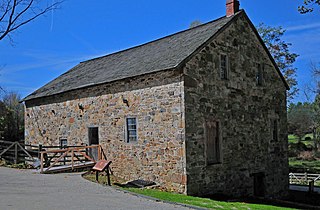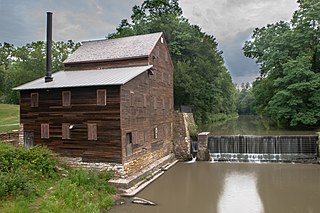
Hubbell Trading Post National Historic Site is a historic site on Highway 191, north of Chambers, with an exhibit center in Ganado, Arizona. It is considered a meeting ground of two cultures between the Navajo and the settlers who came to the area to trade.

The Mill at Anselma is an archetypal small, 18th century custom grain mill in Anselma, outside Chester Springs, Pennsylvania. It is probably the only surviving one in the United States with an intact colonial-era power transmission system. A custom grain mill typically ground cornmeal and flour only for local farmers, not for commercial distribution. It was designated a National Historic Landmark in 2005.

The Fabyan Windmill is an authentic, working Dutch windmill dating from the 1850s located in Geneva, Kane County, Illinois, just north of Batavia, Illinois, off Illinois Route 25. The five-story wooden smock mill with a stage, which stands 68 feet (21 m) tall, sits upon the onetime estate of Colonel George Fabyan, but is now part of the Kane County Forest Preserve District.

Arvada Flour Mill, also known as Tiller's Moving & Storage, Inc. is a vacant flour mill in Arvada, Colorado, that is or was owned by Tiller's Moving & Storage, Inc. It was listed on the National Register of Historic Places in 1975. The Arvada Historical Society owns the mill and provides tours of the Arvada Flour Mill Museum by appointment.

The Quaker Flour Mill, also known as Show Room , is a historic building in Pueblo, Colorado. The building once served as a flour mill and in 1976 it was a theatre. It was listed on the National Register of Historic Places in 1976.

The Sheridan Flouring Mills, also known as the Mill Inn, are an industrial complex in Sheridan, Wyoming. The mills were a major component of the economy of north central Wyoming, providing collection, storage and milling of locally produced wheat and other grains into flour and other milled products. The original mill was established by Captain Scott W. Snively in the early 1890s. The Sheridan Milling and Manufacturing Company was sold to J.W. Denio in 1903, who operated the mill at its location on Broadway Avenue near downtown Sheridan. A catastrophic fire destroyed this mill in 1919, resulting in the purchase of a new location on Coffeen Avenue and construction of a much larger mill.

George Washington's Gristmill was part of the original Mount Vernon plantation, constructed during the lifetime of the United States' first president. The original structure was destroyed about 1850. The Commonwealth of Virginia and the Mount Vernon Ladies’ Association have reconstructed the gristmill and the adjacent distillery. The reconstructed buildings are located at their original site three miles (5 km) west of Mount Vernon proper near Woodlawn Plantation in Alexandria, Virginia. Because the reconstructed buildings embody the distinctive characteristics of late eighteenth century methods of production and are of importance to the history of Virginia, the site is listed on the National Register of Historic Places despite the fact that the buildings are not original.

The First United Methodist Church of Louisa, Kentucky is a historic church built in c.1850. It is located at 204 W. Main Street in Louisa. It was added to the National Register of Historic Places in 1984.

Gaston's Mill-Lock No. 36, Sandy and Beaver Canal District, is a historic district listed in the National Register of Historic Places. The district is located within Beaver Creek State Park, approximately 1 mile south of Clarkson, Ohio. Gaston's Mill was constructed in 1837 and was powered by Little Beaver Creek. Lock 36 was one of 90 locks on the Sandy and Beaver Canal. Construction of this canal began in 1834 but was not completed until 1848.

The Albers Brothers Milling Company building is a historic mill and contemporary office building located on the banks of the Willamette River in Portland, Oregon, United States. In the early decades of the 20th century, the German-immigrant Albers brothers built the largest flour and feed milling enterprise on the West Coast, headquartered in Portland and comprising operations in four states. This combined milling, warehousing, shipping, and office facility, built in 1909–1911, is the oldest remaining flour or feed mill in the city. The silos built into the south elevation of the building are painted with representations some of the mill's products as advertisements.

Causeyville, Mississippi is a small community in southeastern Lauderdale County, Mississippi, about twelve miles southeast of the city of Meridian. The Causeyville Historic District consists of four buildings at the center of the community–two general stores and two residences–that exemplify the pivotal contribution that small communities like Causeyville made to the development of Lauderdale County. The district was added to the National Register of Historic Places in 1986.

Pine Creek Gristmill is a historic building located in Wildcat Den State Park in Muscatine County, Iowa, United States. The building was listed on the National Register of Historic Places in 1979.

The Minden Flour Milling Company is a historic flour mill located at 1609 U.S. Highway 395 in Minden, Nevada. Built in 1906, the mill was the largest of five flour mills built in the Carson Valley and is the only one still in existence. The building has a transitional design in two respects, as it reflects the change from early European-influenced mills to 20th-century American mills as well as the move from smaller rural mills to large mills built along railroads. The mill features a masonry bearing-wall style of construction, a concrete foundation considered novel at the time, and well-crafted masonry and woodwork. The operators of the mill had a significant influence on Minden commerce, as they were instrumental in both the extension of the Virginia and Truckee Railroad to the town and the expansion of electric power to the area. By the 1920s, the mill had become "one of the biggest milling concerns in the state"; it could process 100 barrels of flour a day and also produced chicken and cattle feed. The mill operated until the 1960s.
Dial Mill is a historic gristmill and flour mill outside of Conyers, Georgia. It was added to the National Register of Historic Places on April 6, 1977.

Myrick's Mill is a populated place in Twiggs County, Georgia,. Originally known as Big Sandy, for a large creek in the area, the settlement included a post office, churches, sawmills, ice house and J.D. Myrick's grist mill. Residents produced cotton, fruits and vegetables. The site was added to the National Register of Historic Places on December 6, 1975. The settlement was located northeast of Fitzpatrick, Georgia on county road 378.

Textile Mill Supply Company Building is a historic factory building located at Charlotte, Mecklenburg County, North Carolina. It was designed by Lockwood, Greene & Co. and built in 1922. It is a three-story, ten-bay wide by-five-bay deep, red brick structure with a full basement. It has large rectangular windows and pine post-and-beam interior framing. The building housed the Textile Mill Supply Company that sold and distributed supplies essential to the operations of textile mills in the Piedmont sections of the Carolinas.

The W. R. Stafford Flour Mill and Elevator was a mill located at 4310 Huron Street in Port Hope, Michigan. It was listed on the National Register of Historic Places in 1987 and demolished in the early 2000s.

The Capt. Freese House, on Sycamore St. facing the Big Sandy River in Louisa, Kentucky, United States was built in 1853. It was listed on the National Register of Historic Places in the year 1988.

The Paoli Mills is an early mill complex on the Sugar River in Paoli, Wisconsin, including the remains of a sawmill built in 1849 and a largely intact flour mill begun in the 1860s. In 1979 the complex was added to the National Register of Historic Places.

Dunham's Mill, also known as Parry's Mill, is a historic building located at 7 Lower Center Street in Clinton, New Jersey, United States. The gristmill was in operation from 1837 to 1952. It was added to the National Register of Historic Places on April 15, 1982, for its significance in commerce and industry. In 1995, it was also listed as a contributing property of the Clinton Historic District. It shares the Clinton Dam across the South Branch Raritan River with the David McKinney Mill on the other side of the river. Since 1952, it has been home to the Hunterdon Art Museum, described by an art critic as the "most charming and picturesque" museum in the state.




















